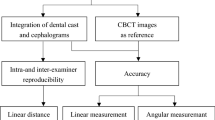Abstract
Aim:
The aim of this study was to examine whether bony, dental and soft tissue landmarks could be placed in CT-based lateral cephalograms with the same precision as in conventional digital lateral cephalograms.
Materials and Methods:
Nine patients without craniofacial dysplasia (2 female, 7 male, aged 12.8–32.3) who had undergone a lateral cephalogram and CT examination within an interval of a maximum of 6.5 months were selected in retrospect. The lateral cephalograms were done with the ORTHOPHOS Plus DS Ceph®, and the CT examination with the SOMATOM Sensation® 16 or 64 scanner. The CT-based cephalograms were generated with the VoXim® 4.3 program based on axial CT reconstructions in the bone window. The cephalograms were analyzed using the Onyx Ceph® 2.7 software by 2 orthodontists and 5 postgraduate students, each cephalogram being examined five times by each examiner on different days. Statistics were compiled with SPSS 13.0 and 14.0 based on the deviation from the individual mean value of each landmark.
Results:
The descriptive statistics showed in the conventional cephalogram, averaged over all 61 landmarks, a mean quartile range of on average 0.62 mm in the horizontal and 0.67 mm in the vertical axes. The CT-based cephalograms ranged between 0.64 mm horizontally and 0.74 mm vertically. The statistics comparing the two types of images with the Wilcoxon test for paired samples showed no significant difference.
Conclusion:
When a CT scan is necessary for assessment of complex craniofacial dysplasias, an orthodontic-specific diagnosis is possible without having to resort to conventional X-rays of the skull. The data from this study demonstrate that it is possible to construct a cephalogram from CT data, which can be analyzed in the same way as a conventional cephalogram provided that the CT's field of view is large enough.
Zusammenfassung
Fragestellung:
Ziel der Studie war es zu untersuchen, ob auf CT-basierten Fernröntgenseitenbildern (FRS) knöcherne, dentale und Weichteilreferenzpunkte mit der gleichen Präzision gesetzt werden können wie auf herkömmlichen digitalen FRS.
Material und Methodik:
Retrospektiv wurden neun Patienten ohne kraniofaziale Fehlbildung (2 weiblich, 7 männlich, 12,8–32,3 Jahre) ausgewählt, bei welchen innerhalb von maximal 6,5 Monaten sowohl ein CT als auch ein digitales FRS erstellt wurden. Die FRS wurden mit dem ORTHOPHOS Plus DS Ceph® erstellt und die CT-Untersuchung mit dem SOMATOM Sensation® 16 bzw. 64 durchgeführt. Die CT-basierten FRS wurden im Programm VoXim® 4.3 auf Basis der axialen Rekonstruktionen im Knochenfenster generiert. Die Analyse aller FRS-Bilder erfolgte mit der Software Onyx Ceph® 2.7 und wurde von zwei Kieferorthopäden und fünf Weiterbildungsassistenten durchgeführt. Jedes Bild wurde pro Untersucher fünfmal an verschiedenen Tagen ausgewertet. Die statistische Analyse erfolgte mit SPSS 13.0 und 14.0. Dabei wurde die Abweichung vom jeweiligen Mittelwert untersucht.
Ergebnisse:
In der deskriptiven Statistik zeigte sich gemittelt über alle 61 betrachteten Punkte im konventionellen FRS in der Horizontalen ein mittlerer Quartilabstand von durchschnittlich 0,62 mm und in der Vertikalen von 0,67 mm. Demgegenüber betrugen die Werte im CT-basierten FRS in der Horizontalen 0,64 mm und in der Vertikalen 0,74 mm. Beim Vergleich der Ergebnisse zwischen beiden Bildtypen mit dem Wilcoxon-Test für verbundene Stichproben ergab sich für alle 61 betrachteten Punkte kein signifikanter Unterschied.
Schlussfolgerung:
Für die Diagnostik komplexer Fehlentwicklungen in der Kieferorthopädie, bei der eine CT-Untersuchung des Schädels notwendig ist, kann unter Zugrundelegung der vorliegenden Daten zur Reduktion der Gesamtstrahlenbelastung auf ein konventionelles FRS verzichtet werden, da sich ein FRS-Bild aus dem vorhandenen CT-Datensatz bei vergleichbarer Auswertbarkeit erstellen lässt, sofern ein ausreichend großes Volumen aufgenommen wurde.
Similar content being viewed by others
Author information
Authors and Affiliations
Corresponding author
Rights and permissions
About this article
Cite this article
Greiner, M., Greiner, A. & Hirschfelder, U. Variance of Landmarks in Digital Evaluations: Comparison between CT-based and Conventional Digital Lateral Cephalometric Radiographs. J Orofac Orthop 68, 290–298 (2007). https://doi.org/10.1007/s00056-007-0710-5
Received:
Accepted:
Issue Date:
DOI: https://doi.org/10.1007/s00056-007-0710-5




